Lisa Dawn's Blog: The Princess Blog, page 58
April 10, 2020
Review: The Stolen Kingdom
The Stolen Kingdom is a retelling of "Aladdin" by Bethany Atazadeh. It was recommended to me by one of my readers. Praising it can feel a little self-indulgent due to the many coincidental similarities it has to my own book,
The Stolen Jewel
. That said, I found the setting and story of The Stolen Kingdom very enjoyable overall. Even though it focuses on the princess from the tale, it is not a gender-bent "Aladdin" retelling like Lucy Tempest's Thief of Cahraman trilogy. It switches to the "Aladdin" character, whose name in this version was Kadin, later in the story. Similar to the Tangled novelizations, the character whose perspective you're reading from changes depending on the chapter. This can get a little jarring because their inner voices weren't all that different even thought their personalities were. I had to go back a few times to check which character was telling the story in that chapter. Aside from that minor nitpick, it is a unique adaptation of "Aladdin" that incorporates a lot of elements I haven't seen in other retellings.
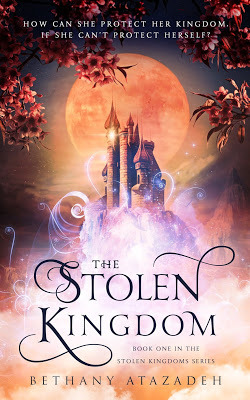
The Stolen Kingdom starts from the perspective of Princess Arie, who was born with the ability to read minds. Arie struggles to hide this ability from the world because she lives in a patriarchy that punishes women who were born with powers even though celebrates men who possess them, especially royals. After reading so many stories about princesses whose independence is celebrated by their society, it was surprisingly difficult to readjust to such an outdated mindset. That's not necessarily think that's a bad thing. In fact, it's refreshing to read about a princess trying to survive in a world that isn't ready to accept her. She learns fairly early in the book that she possesses this ability because of Jinni blood from her late mother's side, but this never gets explored in as much detail as I would have liked. Arie's ability helps her to uncover the plot of an evil king with the power of mind control who wants to use his powers to force her to marry him and take over her kingdom. Arie runs away to try to find a way to stop him and encounters a handsome thief named Kadin along the way. She uses her ability to learn that her goal of finding a Jinni aligns with his, so she teams up with Kadin and his band of thieves. After that, the book's first person perspective shifts between Arie and Kadin, but not necessarily in every chapter.
Jinnis in this story behave differently from the ones Aladdin meets in the original fairy tale. Instead of granting wishes, they are gifted with incredible power that they are bound by law to use for the good of mankind. This creates a challenge for both Arie and Kadin when they track down a Jinni named Gideon. They get Gideon on their side by purchasing an oil lamp that he covets in an auction, even though they don't know exactly what the lamp does. Kadin uses the lamp as collateral for Gideon to punish a wicked prince that he believes is responsible for his brother's death. Gideon picks up on Arie's Jinni blood immediately, but Arie begs him not to tell anyone for the sake of her life. When she learns about Kadin's prejudice toward people with powers, or "Gifts," it becomes even more vital for Arie to keep her ability a secret. I liked how this book put a new twist on the classic theme of being yourself. While Disney's Aladdin was ashamed of being poor, something that is generally seen as a bad thing, Arie is ashamed of being a princess and having a magical ability, things that are generally seen as a good. This gave her character a healthy amount of humility and proficiency for her quest.
There's a lot to love about the world of The Stolen Kingdom. Even though it contains fantasy beings that most of us are already familiar with, it twists what we think we know into something new, giving us something to explore around every corner. Jinnis don't live in rings or lamps in this world nor do they exist for the sole purpose of granting wishes. Princes and kings who abuse their Jinni-given "Gifts" are punished by the Jinn, while women who are discovered to have them are punished by the human monarchy. I would have liked to see the book dive into more of an explanation of Arie's powers and Jinni blood, but I suppose the author is saving that for a later book. The Stolen Kingdom also introduces a race of mermaids called "Meremaids" who live in the ocean and are adorably ignorant about human customs. The end of the book contains a cameo of Rena, the "Little Mermaid" character featured The Jinni Key, the second book in the series. Rena's persistence in following Arie and seeking out sparkly dresses and jewels was just as endearing as it was irritating.
Even though I found The Stolen Kingdom enjoyable overall, the ending fell a little flat. I suppose Bethany Atazadeh wanted to give us a reason read the next book, but it didn't quite have the fairy tale ending I was expecting. The love story between Arie and Kadin is cute and reminds me a the Disney movie, though it never quite reached the same level of passion and charm. Arie falls for Kadin's straightforwardness that confuses her mind reading ability the first time she meets him, while Kadin likes Arie's assertiveness that comes from her upbringing as a princess. The heart of the story revolves not around the romance, but Arie learning to accept her powers and her station in her kingdom. The Stolen Kingdom contains a lovely and engaging fantasy world that any princess fan would love to dive into. I'm looking forward to reading The Jinni Key next to learn more about the Meremaids and discover Rena's story. Hopefully, Arie's tale gets a more fulfilling resolution there as well.

The Stolen Kingdom starts from the perspective of Princess Arie, who was born with the ability to read minds. Arie struggles to hide this ability from the world because she lives in a patriarchy that punishes women who were born with powers even though celebrates men who possess them, especially royals. After reading so many stories about princesses whose independence is celebrated by their society, it was surprisingly difficult to readjust to such an outdated mindset. That's not necessarily think that's a bad thing. In fact, it's refreshing to read about a princess trying to survive in a world that isn't ready to accept her. She learns fairly early in the book that she possesses this ability because of Jinni blood from her late mother's side, but this never gets explored in as much detail as I would have liked. Arie's ability helps her to uncover the plot of an evil king with the power of mind control who wants to use his powers to force her to marry him and take over her kingdom. Arie runs away to try to find a way to stop him and encounters a handsome thief named Kadin along the way. She uses her ability to learn that her goal of finding a Jinni aligns with his, so she teams up with Kadin and his band of thieves. After that, the book's first person perspective shifts between Arie and Kadin, but not necessarily in every chapter.
Jinnis in this story behave differently from the ones Aladdin meets in the original fairy tale. Instead of granting wishes, they are gifted with incredible power that they are bound by law to use for the good of mankind. This creates a challenge for both Arie and Kadin when they track down a Jinni named Gideon. They get Gideon on their side by purchasing an oil lamp that he covets in an auction, even though they don't know exactly what the lamp does. Kadin uses the lamp as collateral for Gideon to punish a wicked prince that he believes is responsible for his brother's death. Gideon picks up on Arie's Jinni blood immediately, but Arie begs him not to tell anyone for the sake of her life. When she learns about Kadin's prejudice toward people with powers, or "Gifts," it becomes even more vital for Arie to keep her ability a secret. I liked how this book put a new twist on the classic theme of being yourself. While Disney's Aladdin was ashamed of being poor, something that is generally seen as a bad thing, Arie is ashamed of being a princess and having a magical ability, things that are generally seen as a good. This gave her character a healthy amount of humility and proficiency for her quest.
There's a lot to love about the world of The Stolen Kingdom. Even though it contains fantasy beings that most of us are already familiar with, it twists what we think we know into something new, giving us something to explore around every corner. Jinnis don't live in rings or lamps in this world nor do they exist for the sole purpose of granting wishes. Princes and kings who abuse their Jinni-given "Gifts" are punished by the Jinn, while women who are discovered to have them are punished by the human monarchy. I would have liked to see the book dive into more of an explanation of Arie's powers and Jinni blood, but I suppose the author is saving that for a later book. The Stolen Kingdom also introduces a race of mermaids called "Meremaids" who live in the ocean and are adorably ignorant about human customs. The end of the book contains a cameo of Rena, the "Little Mermaid" character featured The Jinni Key, the second book in the series. Rena's persistence in following Arie and seeking out sparkly dresses and jewels was just as endearing as it was irritating.
Even though I found The Stolen Kingdom enjoyable overall, the ending fell a little flat. I suppose Bethany Atazadeh wanted to give us a reason read the next book, but it didn't quite have the fairy tale ending I was expecting. The love story between Arie and Kadin is cute and reminds me a the Disney movie, though it never quite reached the same level of passion and charm. Arie falls for Kadin's straightforwardness that confuses her mind reading ability the first time she meets him, while Kadin likes Arie's assertiveness that comes from her upbringing as a princess. The heart of the story revolves not around the romance, but Arie learning to accept her powers and her station in her kingdom. The Stolen Kingdom contains a lovely and engaging fantasy world that any princess fan would love to dive into. I'm looking forward to reading The Jinni Key next to learn more about the Meremaids and discover Rena's story. Hopefully, Arie's tale gets a more fulfilling resolution there as well.
Published on April 10, 2020 13:02
April 5, 2020
COVID-19 Updates from the Kingdoms
We've been locked in our towers for weeks now with no word from Mother Gothel on when we can go back outside. This is a hard time for everyone, including fairy tale princesses. If you've been too stressed to keep up with the ever-changing schedules for upcoming princess movies and events, don't worry. I've got you covered. As we all know, the Disney Parks are now closed indefinitely around the world. However, Disney cast members are being placed on furlough so they can still get paid during these uncertain times. Movie productions have been delayed as well. The live-action Mulan, which was supposed to come out in theaters on March 27th, is now set for theatrical release on July 24, 2020. Another upcoming princess remake, The Little Mermaid starring

Just because we can't go to the theater doesn't mean we can't enjoy princess stories from the comfort of our own home. Disney has released several movies early on their Disney+ streaming service in light of the pandemic, including Frozen 2 and Pixar's Onward. Some people were hoping that the new Mulan would also premiere on the streaming service after the delay, but the new July 24th theatrical release date tells us otherwise. However, you can still go on some new adventures with Mulan right now from your smartphone. She is the newest princess on the Disney Princess Majestic Quest app. Little is known about the original princess content that was set to come to Disney+ this year such as Secret Society of Second-Born Royals and Godmothered. Some good news is that the third and final season of Tangled: The Series is still set for release on April 23rd, allowing those who missed it to binge the entire show on the streaming platform. The last season of She-Ra and the Princesses of Power launches on Netflix on May 15th, giving us more to look forward to in the coming months.
YouTubers have started a new trend of filming videos from home. The talented singers from the Broadway Princess Party can't do live shows right now, so instead, they made this hilarious parody of "Go the Distance" from Disney's Hercules called "Keep Your Distance." The new music video features on-point quarantine footage such as Susan Egan taking her daughter's temperature while wearing thick rubber gloves and standing as far away as she can and Laura Osnes cuddling the most enormous value pack of toilet paper I have ever seen. It's wonderful that these girls have such a great sense of humor about the cancellation of their ongoing tour. Princess YouTuber Sarah Ingle recently recorded a 1950s-style PSA called "How to Stay Home Like Rapunzel" in which she cosplays as her favorite princess and humorously performs the chores referenced in Rapunzel's iconic song "When Will My Life Begin?"
Social media is more active than ever right now with live video streams, group chats, and online events. Author A.G. Marshall recently started a series of posts in her Fairytale Courtyard group on Facebook for people to vote for which Disney character they would rather quarantine with. You can choose between two of your favorite princesses, villains, cats, or dwarfs. Author Lucy Tempest recently started her own Facebook group for fans of her books as well. A popular social app right now is Netflix Party, a third-party browser plugin that you can use to sync up your Netflix stream with your friends and chat with them about what you're watching in a sidebar in real-time. This seems like an ideal option for a virtual princess marathon. There are lots of other free shows available online to stream and discuss with your friends right now as well, such as some of Andrew Lloyd Webber's older musicals and the lovely Little Mermaid ballet I reviewed last week.
Finally, I'd like to pay tribute to a tragic loss the entertainment world suffered due to complications from the coronavirus. Adam Schlesinger was the musical genius behind many of my favorite songs from the show Crazy Ex-Girlfriend, which served as a deconstruction of the romantic comedy and fairy tale genres. Adam was hospitalized on a ventilator when he contracted the illness and passed away on April 1st. I've seen him perform live several times, and his loss is a huge tragedy to anyone who loves music. I'm sorry to have to end on such a sad note. Stay indoors, wash your hands, and continue to follow social distancing guidelines. Together, we will get through this.

Just because we can't go to the theater doesn't mean we can't enjoy princess stories from the comfort of our own home. Disney has released several movies early on their Disney+ streaming service in light of the pandemic, including Frozen 2 and Pixar's Onward. Some people were hoping that the new Mulan would also premiere on the streaming service after the delay, but the new July 24th theatrical release date tells us otherwise. However, you can still go on some new adventures with Mulan right now from your smartphone. She is the newest princess on the Disney Princess Majestic Quest app. Little is known about the original princess content that was set to come to Disney+ this year such as Secret Society of Second-Born Royals and Godmothered. Some good news is that the third and final season of Tangled: The Series is still set for release on April 23rd, allowing those who missed it to binge the entire show on the streaming platform. The last season of She-Ra and the Princesses of Power launches on Netflix on May 15th, giving us more to look forward to in the coming months.
YouTubers have started a new trend of filming videos from home. The talented singers from the Broadway Princess Party can't do live shows right now, so instead, they made this hilarious parody of "Go the Distance" from Disney's Hercules called "Keep Your Distance." The new music video features on-point quarantine footage such as Susan Egan taking her daughter's temperature while wearing thick rubber gloves and standing as far away as she can and Laura Osnes cuddling the most enormous value pack of toilet paper I have ever seen. It's wonderful that these girls have such a great sense of humor about the cancellation of their ongoing tour. Princess YouTuber Sarah Ingle recently recorded a 1950s-style PSA called "How to Stay Home Like Rapunzel" in which she cosplays as her favorite princess and humorously performs the chores referenced in Rapunzel's iconic song "When Will My Life Begin?"
Social media is more active than ever right now with live video streams, group chats, and online events. Author A.G. Marshall recently started a series of posts in her Fairytale Courtyard group on Facebook for people to vote for which Disney character they would rather quarantine with. You can choose between two of your favorite princesses, villains, cats, or dwarfs. Author Lucy Tempest recently started her own Facebook group for fans of her books as well. A popular social app right now is Netflix Party, a third-party browser plugin that you can use to sync up your Netflix stream with your friends and chat with them about what you're watching in a sidebar in real-time. This seems like an ideal option for a virtual princess marathon. There are lots of other free shows available online to stream and discuss with your friends right now as well, such as some of Andrew Lloyd Webber's older musicals and the lovely Little Mermaid ballet I reviewed last week.
Finally, I'd like to pay tribute to a tragic loss the entertainment world suffered due to complications from the coronavirus. Adam Schlesinger was the musical genius behind many of my favorite songs from the show Crazy Ex-Girlfriend, which served as a deconstruction of the romantic comedy and fairy tale genres. Adam was hospitalized on a ventilator when he contracted the illness and passed away on April 1st. I've seen him perform live several times, and his loss is a huge tragedy to anyone who loves music. I'm sorry to have to end on such a sad note. Stay indoors, wash your hands, and continue to follow social distancing guidelines. Together, we will get through this.
Published on April 05, 2020 13:01
April 3, 2020
Review: Dagger's Sleep
Dagger's Sleep by Tricia Mingerink is the last book I had left to read from National Tell a Fairy Tale Day. It's the first in a series called Beyond the Tales, which seems to be similar to Aya Ling's Reversed Retellings in that they both contain gender-bent adaptations of popular fairy tales. Like Aya Ling's The Cursed Prince, Dagger's Sleep is a gender-bent retelling of "Sleeping Beauty." Aside from the basic premise, the two books are different enough to enjoy separately. Dagger's Sleep is a more progressive take on the classic fairy tale. The setting is loosely Native American and incorporates some cultural and religious undertones. It was quite unique for a "Sleeping Beauty" retelling and uses some less popular aspects of the story, such as the 100 year passage of time.
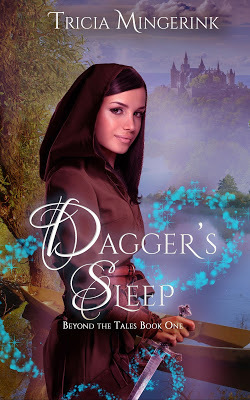
The best way I can describe Dagger's Sleep is that it felt like a cross between Charles Perrault's "Sleeping Beauty" and Disney's Pocahontas. Princess Rosanna lives in a land that resembles something between a Native American village and a medieval kingdom. She is a nature child who enjoys riding her canoe around the riverbend with her friend Isi. Her life is flipped upside-down when a messenger named Daemyn arrives to tell her that she is the fabled cursebreaker who is destined to wake the sleeping High Prince Alexander from his century-old curse. The journey won't be easy. Her kingdom has many enemies who don't want the prince to wake up and end the war for ownership between its two provinces. Rosanna's family, friends, and guards must do everything in their power to protect her and make sure she is successful in her quest to awaken the prince and end the war.
The book alternates between the present time and 100 years earlier when the prince went on his own journey to see if he could get the fae to lift the curse that would cause him to prick his finger on his dagger on his 21st birthday and sleep for 100 years. At first, I didn't think these chapters added much to the story, possibly because I've read so many other retellings of "Sleeping Beauty" where the cursed princess tries to convince the fae to lift the curse. However, when I got about halfway through the book, I understood that the flashback sequences were really about the prince's servant Jadon teaching him humility. The story became significantly more interesting after that, but the first half felt like it was mostly filler, alternating between Rosanna' and Alex's journeys through various parts of the kingdom to achieve their goals. This book would probably appeal more to environmentalists who enjoy lush descriptions of natural environments.
Most "Sleeping Beauty" adaptations avoid the 100 year gap because it eliminates the possibility for romance to blossom between the two main love interests before one of them falls asleep. This book resolved that by giving Rosanna a different love interest than the prince. In fact, she doesn't even wake Alexander with a kiss, something that made this version truly unique. I appreciated that Tricia Mingerink got so creative with her interpretation of the story, but I didn't find the romance as engaging as I would have liked. Rosanna was so busy trying to prevent a war for most of the book that it seemed like she didn't have time to think about romance until the end. Much like Pocahontas, she was a very independent person who never needed someone else to make her life fulfilling. In fact, Rosanna is one of the most progressive heroines I've ever seen in a "Sleeping Beauty" adaptation, which is quite telling on the possibilities to modernize even the ultimate "damsel in distress" story.
Overall, Dagger's Sleep is one of the most creative retellings of "Sleeping Beauty" I've ever read. It wasn't my favorite due to the war background and underplayed romance, but I have to give credit where credit is due. Rosanna is a terrific modern-day princess who knows how to take care of herself and go on her own adventures. The Native American elements added a unique cultural perspective to the story that made it feel fresh. Even though some of the flashbacks felt unnecessary, all the loose ends were tied together by the end. The love interest was a fascinatingly complex character, and it was a pleasure learn his secrets. I would recommend this book to anyone who disliked elements of the original "Sleeping Beauty" and wants a more modern take on the classic fairy tale.

The best way I can describe Dagger's Sleep is that it felt like a cross between Charles Perrault's "Sleeping Beauty" and Disney's Pocahontas. Princess Rosanna lives in a land that resembles something between a Native American village and a medieval kingdom. She is a nature child who enjoys riding her canoe around the riverbend with her friend Isi. Her life is flipped upside-down when a messenger named Daemyn arrives to tell her that she is the fabled cursebreaker who is destined to wake the sleeping High Prince Alexander from his century-old curse. The journey won't be easy. Her kingdom has many enemies who don't want the prince to wake up and end the war for ownership between its two provinces. Rosanna's family, friends, and guards must do everything in their power to protect her and make sure she is successful in her quest to awaken the prince and end the war.
The book alternates between the present time and 100 years earlier when the prince went on his own journey to see if he could get the fae to lift the curse that would cause him to prick his finger on his dagger on his 21st birthday and sleep for 100 years. At first, I didn't think these chapters added much to the story, possibly because I've read so many other retellings of "Sleeping Beauty" where the cursed princess tries to convince the fae to lift the curse. However, when I got about halfway through the book, I understood that the flashback sequences were really about the prince's servant Jadon teaching him humility. The story became significantly more interesting after that, but the first half felt like it was mostly filler, alternating between Rosanna' and Alex's journeys through various parts of the kingdom to achieve their goals. This book would probably appeal more to environmentalists who enjoy lush descriptions of natural environments.
Most "Sleeping Beauty" adaptations avoid the 100 year gap because it eliminates the possibility for romance to blossom between the two main love interests before one of them falls asleep. This book resolved that by giving Rosanna a different love interest than the prince. In fact, she doesn't even wake Alexander with a kiss, something that made this version truly unique. I appreciated that Tricia Mingerink got so creative with her interpretation of the story, but I didn't find the romance as engaging as I would have liked. Rosanna was so busy trying to prevent a war for most of the book that it seemed like she didn't have time to think about romance until the end. Much like Pocahontas, she was a very independent person who never needed someone else to make her life fulfilling. In fact, Rosanna is one of the most progressive heroines I've ever seen in a "Sleeping Beauty" adaptation, which is quite telling on the possibilities to modernize even the ultimate "damsel in distress" story.
Overall, Dagger's Sleep is one of the most creative retellings of "Sleeping Beauty" I've ever read. It wasn't my favorite due to the war background and underplayed romance, but I have to give credit where credit is due. Rosanna is a terrific modern-day princess who knows how to take care of herself and go on her own adventures. The Native American elements added a unique cultural perspective to the story that made it feel fresh. Even though some of the flashbacks felt unnecessary, all the loose ends were tied together by the end. The love interest was a fascinatingly complex character, and it was a pleasure learn his secrets. I would recommend this book to anyone who disliked elements of the original "Sleeping Beauty" and wants a more modern take on the classic fairy tale.
Published on April 03, 2020 14:11
March 30, 2020
This Little Mermaid Ballet Is a Beautiful Tribute to Hans Christian Andersen
As a result of the virus in Corona, a lot of live experiences that are no longer available to the public are being shared online for free. One such is experience is the lovely Finnish ballet of "The Little Mermaid" produced by Oopera Baletti. Last night, I had the pleasure of watching the show in its entirety and found that it is not only a unique retelling of the fairy tale, but also a beautiful tribute to the story's original author, Hans Christian Andersen. Andersen plays a unique role in this ballet in which he acts as a storyteller as well as a fairy godmother of sorts for the mermaid character. I loved the elegant way that the mermaid ballerinas were portrayed in the show as well as the brief nods to Andersen's other famous works.
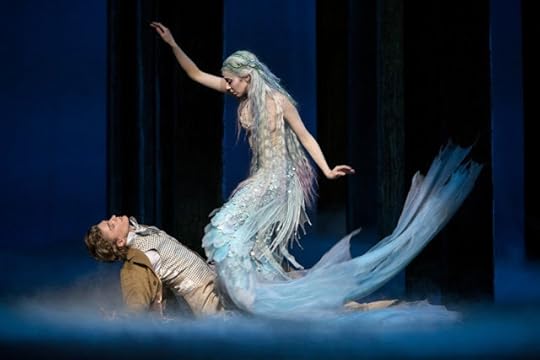
Though most of the story is told through dance, there were some short Finnish narrations throughout the show that I was unable to understand, so it's possible that some of my interpretation is wrong. If I'm not mistaken, this ballet submits to the theory that Hans Christian Andersen wrote "The Little Mermaid" as a metaphor for his unrequited love toward another man. Andersen led a lonely life and loved many women and men, but none of them shared his romantic affections. The Oopera Balleti portrays this with a scene in which Andersen appears to pine for the prince during a ball and angers the other members of the royal court. Andersen attempts to drown himself in shame when the prince takes pity on him. Unfortunately, when he attempts to recover Anderson's belongings from the dock, the prince falls into the water where he is rescued by the mermaid. Hans and the mermaid visit the sea witch together to ask for a way to win the prince's heart. After Hans regales her with the stories of "The Ugly Duckling" and "The Little Match Girl," the witch gives them a magic potion, but Hans chooses not to take it in order to give the mermaid her best chance.
This version of "The Little Mermaid" draws some inspiration from the Swan Lake ballet. In the same way that the Black Swan character charmed the prince away from Odette, causing her death, this show has a character who I will refer to as the "black siren," who represents the princess from "The Little Mermaid" who marries the prince after he comes to believe that she was the one who rescued him from drowning. The black siren plays a larger role in this ballet than she did in the fairy tale and her wicked intentions are less ambiguous after she steals the magic potion from Hans Christian Andersen to charm the prince for herself. The potion is the same as the one that the mermaid drinks to become human but has no physical effect on the black siren, likely because she is already beautiful and has two legs.
Hans Christian Andersen makes every effort to break up the prince and the black siren to bring him back to the little mermaid, but his efforts end in failure. After the famous scene in which the mermaid refuses to kill the prince in order to rejoin her family in the sea, the sea witch appears and creates a massive storm before she stabs the mermaid in cold blood. Only then does the prince realize that she was the one who saved him. He mourns her death along with lots of human funeral-goers who had no real reason to mourn her because the only people who knew her lived in the sea. In his grievance, the prince is finally willing to accept Hans's advances, but Hans is too saddened by the death of the mermaid to accept him. There are no Daughters of the Air in this version, and it ends with Hans Christian Andersen looking out to sea at the famous Little Mermaid statue in Denmark.
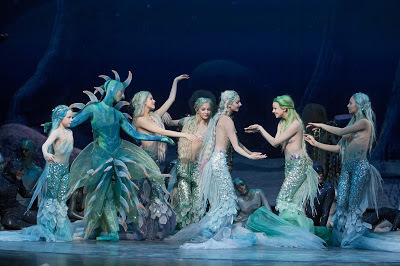
My favorite aspect of this ballet by far was the aesthetic. The long flipper shoes that trailed with flowing chiffon combined with the graceful moments of the mermaid dancers created a much better illusion of mermaids than the heelies and spring tails that Disney used in their Broadway production. I also liked the minimalist glitter pasties that the mermaids wore on their upper halves that created the illusion of otherworldly fashion. Their long flowing blue and green hair added just the right touch. The elaborate throne that the sea witch sits in during her first appearance is also incredibly impressive. The dress that the black siren wore did a great job of expressing her personality with its glittering black flowers overlaying sheer flowing fabric. Many modern shows go overboard with the use of projection effects, and I think this one uses just the right amount of CGI without drawing attention away from the performers, especially during the storm at the end.
If you love "The Little Mermaid" as much as I do, you should definitely take advantage of this unique opportunity to watch Oopera Baletti's show online for free. I was impressed by how fluidly they incorporated Hans Christian Andersen and his motivations behind writing the story without getting too distracting. It was also great how they were able to pay homage to his other stories without interrupting the main plot. With the inclusion of Hans pining for the prince alongside the mermaid, this show truly drives home the theme of unrequited love from the original fairy tale. My biggest disappointment was that mermaid was murdered at the end instead of sacrificing herself for the prince and becoming a Daughter of the Air, something I expanded on in my own version. This ending diminished her sacrifice and freedom of choice.

Though most of the story is told through dance, there were some short Finnish narrations throughout the show that I was unable to understand, so it's possible that some of my interpretation is wrong. If I'm not mistaken, this ballet submits to the theory that Hans Christian Andersen wrote "The Little Mermaid" as a metaphor for his unrequited love toward another man. Andersen led a lonely life and loved many women and men, but none of them shared his romantic affections. The Oopera Balleti portrays this with a scene in which Andersen appears to pine for the prince during a ball and angers the other members of the royal court. Andersen attempts to drown himself in shame when the prince takes pity on him. Unfortunately, when he attempts to recover Anderson's belongings from the dock, the prince falls into the water where he is rescued by the mermaid. Hans and the mermaid visit the sea witch together to ask for a way to win the prince's heart. After Hans regales her with the stories of "The Ugly Duckling" and "The Little Match Girl," the witch gives them a magic potion, but Hans chooses not to take it in order to give the mermaid her best chance.
This version of "The Little Mermaid" draws some inspiration from the Swan Lake ballet. In the same way that the Black Swan character charmed the prince away from Odette, causing her death, this show has a character who I will refer to as the "black siren," who represents the princess from "The Little Mermaid" who marries the prince after he comes to believe that she was the one who rescued him from drowning. The black siren plays a larger role in this ballet than she did in the fairy tale and her wicked intentions are less ambiguous after she steals the magic potion from Hans Christian Andersen to charm the prince for herself. The potion is the same as the one that the mermaid drinks to become human but has no physical effect on the black siren, likely because she is already beautiful and has two legs.
Hans Christian Andersen makes every effort to break up the prince and the black siren to bring him back to the little mermaid, but his efforts end in failure. After the famous scene in which the mermaid refuses to kill the prince in order to rejoin her family in the sea, the sea witch appears and creates a massive storm before she stabs the mermaid in cold blood. Only then does the prince realize that she was the one who saved him. He mourns her death along with lots of human funeral-goers who had no real reason to mourn her because the only people who knew her lived in the sea. In his grievance, the prince is finally willing to accept Hans's advances, but Hans is too saddened by the death of the mermaid to accept him. There are no Daughters of the Air in this version, and it ends with Hans Christian Andersen looking out to sea at the famous Little Mermaid statue in Denmark.

My favorite aspect of this ballet by far was the aesthetic. The long flipper shoes that trailed with flowing chiffon combined with the graceful moments of the mermaid dancers created a much better illusion of mermaids than the heelies and spring tails that Disney used in their Broadway production. I also liked the minimalist glitter pasties that the mermaids wore on their upper halves that created the illusion of otherworldly fashion. Their long flowing blue and green hair added just the right touch. The elaborate throne that the sea witch sits in during her first appearance is also incredibly impressive. The dress that the black siren wore did a great job of expressing her personality with its glittering black flowers overlaying sheer flowing fabric. Many modern shows go overboard with the use of projection effects, and I think this one uses just the right amount of CGI without drawing attention away from the performers, especially during the storm at the end.
If you love "The Little Mermaid" as much as I do, you should definitely take advantage of this unique opportunity to watch Oopera Baletti's show online for free. I was impressed by how fluidly they incorporated Hans Christian Andersen and his motivations behind writing the story without getting too distracting. It was also great how they were able to pay homage to his other stories without interrupting the main plot. With the inclusion of Hans pining for the prince alongside the mermaid, this show truly drives home the theme of unrequited love from the original fairy tale. My biggest disappointment was that mermaid was murdered at the end instead of sacrificing herself for the prince and becoming a Daughter of the Air, something I expanded on in my own version. This ending diminished her sacrifice and freedom of choice.
Published on March 30, 2020 18:49
March 29, 2020
Review: Cinders
I have a weakness for visual novels. It took way too long for them to become popular in western society, which made me learn about them later in life than I would have liked. Visual novels are a mix of video games and books. You read all the dialogue at the bottom of the screen while watching an image of the character who's speaking over a background illustration set to music. The thing makes them unique is the ability to make decisions for the main character and choose how they react to the situation, which may change the outcome of their story. It's a technologically advanced version of a "Choose Your Own Adventure" book. Since visual novels tend to cost closer to the price of a video game than a book, I usually stick to free smartphone ones such as Lovestruck: Choose Your Romance. However, since I'm going to be locked in my tower indefinitely, I decided it might be worth dishing out some extra money to play Cinders, a visual novel that lets you enter the fairy tale world of "Cinderella" and determine how her story will end.
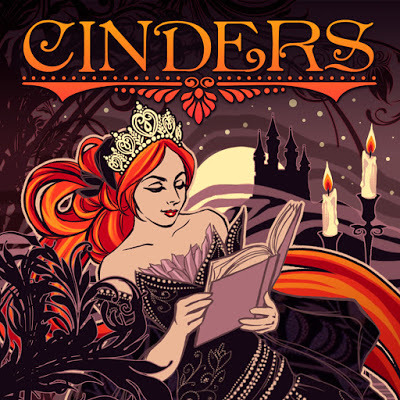
As soon as I started playing Cinders, I deactivated the in-game sound effects. It makes a terrible clicking noise every time a character speaks, which I guess is supposed to represent their voice even though I don't know anyone who makes clicking noises when they talk. Without the clicking, the music and illustrations are very pleasant and reminiscent of a Victorian fairy tale world. The story is one that we are all familiar with, but the game allows you to do things that many people wish Cinderella would have done, such as talking back to her evil stepmother and attempting to reclaim her father's residence. Whether or not you are successful in getting the ending you want depends on the decisions throughout the course of the game. There are four main endings, but each one has a number of variables that change based on your behavior and how you treat other people.
The biggest appeal of visual novels is the ability to choose from a number of love interests who have romantic potential with your character. This game is no exception. The prince should the most obvious option, but he is actually the hardest one to get because Cinders only sees him one time at the ball. He falls in love with her no matter who you choose as her love interest, but in order to get Cinders to reciprocate his love, you have to make one specific decision very early in the game that could easily be missed. You also have to avoid showing romantic interest in her childhood friend, Tobias, or the Captain of the Guard, Perrault, even though they go out of their way to attract her affections multiple times before she encounters the prince. Tobias seemed like the best option for Cinders in my first playthrough because she knew him the longest. However, earning the affections of the Captain of the Guard can literally allow you to get away with murder in one of the endings.
Cinders also expands on the personalities of the stepsisters, Sophia and Gloria. Sophia reveals that she likes to pick on Cinders because she used to be the family scapegoat before her mother remarried, so bullying Cinders means that she gets bullied less. Gloria picks on Cinders because she wants to earn her mother's approval by being just like her. The stepmother, Carmosa, runs the household with an iron fist. It's possible for Cinders to earn Carmosa's approval by digging up dirt that she's hiding and proving that she can be just as manipulative. Earning the favor of the stepsisters also changes the conversations that they have with the prince during the ball. I personally would have liked to see some dialogue for some of the servants in the household since Cinders often mentions how her family forces her to help them even though we never see them. I actually think a servant would have made a better romance option than the Captain of the Guard because it would give her Cinders a love interest to stay with if she chooses to re-take the residence.
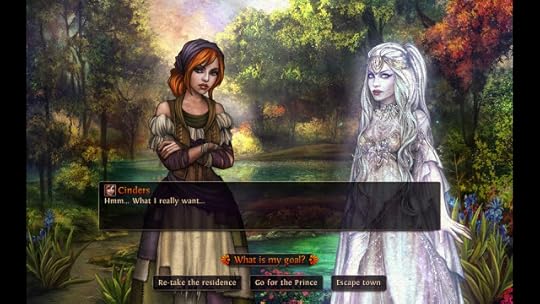
If you enjoy the story of "Cinderella," I definitely recommend playing through Cinders at least once if you don't mind spending $20 on a visual novel. It gives you a deeper dive into Cinderella's world than any movie or book ever could and allows you to determine whether marrying the prince is rthe right choice for her and if so, what kind of queen she will become. I was so fascinated by how many different scenes you can unlock by making different decisions that I ended up getting 100% of the variables for each ending. I don't recommend doing this unless you're as OCD as I am. Repeating the game can feel very tedious after the fourth or fifth playthrough even though it lets you fast forward through conversations that you've already seen. Still, the story was very complete, and it was exciting to discover new dialogue in each playthrough.

As soon as I started playing Cinders, I deactivated the in-game sound effects. It makes a terrible clicking noise every time a character speaks, which I guess is supposed to represent their voice even though I don't know anyone who makes clicking noises when they talk. Without the clicking, the music and illustrations are very pleasant and reminiscent of a Victorian fairy tale world. The story is one that we are all familiar with, but the game allows you to do things that many people wish Cinderella would have done, such as talking back to her evil stepmother and attempting to reclaim her father's residence. Whether or not you are successful in getting the ending you want depends on the decisions throughout the course of the game. There are four main endings, but each one has a number of variables that change based on your behavior and how you treat other people.
The biggest appeal of visual novels is the ability to choose from a number of love interests who have romantic potential with your character. This game is no exception. The prince should the most obvious option, but he is actually the hardest one to get because Cinders only sees him one time at the ball. He falls in love with her no matter who you choose as her love interest, but in order to get Cinders to reciprocate his love, you have to make one specific decision very early in the game that could easily be missed. You also have to avoid showing romantic interest in her childhood friend, Tobias, or the Captain of the Guard, Perrault, even though they go out of their way to attract her affections multiple times before she encounters the prince. Tobias seemed like the best option for Cinders in my first playthrough because she knew him the longest. However, earning the affections of the Captain of the Guard can literally allow you to get away with murder in one of the endings.
Cinders also expands on the personalities of the stepsisters, Sophia and Gloria. Sophia reveals that she likes to pick on Cinders because she used to be the family scapegoat before her mother remarried, so bullying Cinders means that she gets bullied less. Gloria picks on Cinders because she wants to earn her mother's approval by being just like her. The stepmother, Carmosa, runs the household with an iron fist. It's possible for Cinders to earn Carmosa's approval by digging up dirt that she's hiding and proving that she can be just as manipulative. Earning the favor of the stepsisters also changes the conversations that they have with the prince during the ball. I personally would have liked to see some dialogue for some of the servants in the household since Cinders often mentions how her family forces her to help them even though we never see them. I actually think a servant would have made a better romance option than the Captain of the Guard because it would give her Cinders a love interest to stay with if she chooses to re-take the residence.

If you enjoy the story of "Cinderella," I definitely recommend playing through Cinders at least once if you don't mind spending $20 on a visual novel. It gives you a deeper dive into Cinderella's world than any movie or book ever could and allows you to determine whether marrying the prince is rthe right choice for her and if so, what kind of queen she will become. I was so fascinated by how many different scenes you can unlock by making different decisions that I ended up getting 100% of the variables for each ending. I don't recommend doing this unless you're as OCD as I am. Repeating the game can feel very tedious after the fourth or fifth playthrough even though it lets you fast forward through conversations that you've already seen. Still, the story was very complete, and it was exciting to discover new dialogue in each playthrough.
Published on March 29, 2020 10:51
March 27, 2020
Review: The Storyteller's Daughter
I was recently offered an advance copy of
The Storyteller's Daughter
by Victoria McCombs in exchange for my honest review. This book is a retelling of "Rumpelstiltskin," a story I've read a couple other adaptations of. This version was more similar to the way it was presented in ABC's Once Upon a Time than the loose interpretations I've read in the past. The book also seems more appropriate for younger audiences than some of the ones I've read in the past. It is marketed toward fans of Gail Carson Levine and Jessica Day George, which seems appropriate due to the simplistic storytelling style and first person narrative. There were aspects of it that bugged me as an older ready, but I think it's a great book for teenagers who love fairy tales and princesses. It will be released by Parliament Press on July 14th.
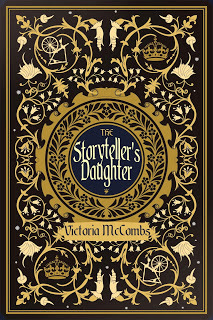
The Storyteller's Daughter is set in a world where everyone has a magical power except for the main character, Cosette. The world reminded me of the anime My Hero Academia, though it never quite reached that level of creativity. Most of the powers listed were mundane such as singing, storytelling, and a hilariously bizarre ability to turn apples into peaches on Saturdays. I would have loved to see more about how these powers are incorporated into the kingdom of Westfallen, but there is little mention aside from needing the abilities to help with the war effort. However, the soldiers' abilities must not be enough for the kingdom to win the war or the king wouldn't have needed someone who can spin straw into gold so he can end it through monetary means. The only character whose magical abilities have any relevance to the story is Rumpelstiltskin, who has seemingly limitless magic despite being under a mysterious curse.
No matter how hard I tried, I found that I had trouble relating to Cosette. She was supposed to sympathetic because of her insecurities over not having a superpower like the rest of the people in her kingdom, but she came off as a Mary Sue regardless. Every eligible man she met seemed to be madly in love with her, and her rejections of them seemed to come from a place of arrogant elitism. Aside from that, she had all of her problems solved for her by Rumpelstiltskin, even at times when it didn't seem feasible for him to be able to help her. I appreciate that he briefly addressed the issue of Cosette getting too spoiled after being taken from her parents' tavern to live in a palace with a maid, but that was never brought up again after Cosette decided that he was wrong. There was no point in the book where I felt as though she earned any of the things that were offered to her as a result of her father's story that she could spin straw into gold. She reminded me of Bella Swan from the Twilight books.
Rumpelstiltskin, on the other hand, was more flawed and interesting than Cosette, but calling his situation a curse seemed like a gross exaggeration. Sure, he couldn't leave the castle, but in exchange, he had unlimited power at his command and an extended lifespan without any of the detriments of growing old. It seems like the author wanted to build him up as a tragic Phantom of the Opera/"Beauty and the Beast" figure, but he was often described as handsome and didn't require Cosette to look past any sort of gruff exterior to see his true self. It's no wonder he was attracted to someone as young and lovely as Cosette at his age, but making him a love interest bordered on creepy territory for me. He came off as a father figure, giving her sage advice from his long life and helping her stay out of trouble by keeping up the guise that she could spin straw into gold. Rumpelstiltskin had a difficult life and lost his first wife, but it felt more appropriate to me for him to want one last reprieve than to start over again as though his past never happened.
The Storyteller's Daughter was a nice light romance that was a quick and easy read. It would be great for teenage readers who enjoy paranormal love triangles like the Twilight series. In spite of all the king's threats to kill Cosette if she didn't succeed to spin straw into gold, I never felt worried for her because Rumpelstiltskin was there to save her at every turn. If I could make a suggestion to the author, it would be to include a situation where Rumpelstiltskin was unable to help Cosette, forcing her to come up with a way out on her own merit despite not having a superpower. I also wished she had chosen a different love interest because I think she would have had more to offer to a relationship with someone her own age. Overall, The Storyteller's Daughter is a nice starter book for young readers who want to break into the fairy tale adaptation genre. Look for it at your preferred bookseller on July 14th.

The Storyteller's Daughter is set in a world where everyone has a magical power except for the main character, Cosette. The world reminded me of the anime My Hero Academia, though it never quite reached that level of creativity. Most of the powers listed were mundane such as singing, storytelling, and a hilariously bizarre ability to turn apples into peaches on Saturdays. I would have loved to see more about how these powers are incorporated into the kingdom of Westfallen, but there is little mention aside from needing the abilities to help with the war effort. However, the soldiers' abilities must not be enough for the kingdom to win the war or the king wouldn't have needed someone who can spin straw into gold so he can end it through monetary means. The only character whose magical abilities have any relevance to the story is Rumpelstiltskin, who has seemingly limitless magic despite being under a mysterious curse.
No matter how hard I tried, I found that I had trouble relating to Cosette. She was supposed to sympathetic because of her insecurities over not having a superpower like the rest of the people in her kingdom, but she came off as a Mary Sue regardless. Every eligible man she met seemed to be madly in love with her, and her rejections of them seemed to come from a place of arrogant elitism. Aside from that, she had all of her problems solved for her by Rumpelstiltskin, even at times when it didn't seem feasible for him to be able to help her. I appreciate that he briefly addressed the issue of Cosette getting too spoiled after being taken from her parents' tavern to live in a palace with a maid, but that was never brought up again after Cosette decided that he was wrong. There was no point in the book where I felt as though she earned any of the things that were offered to her as a result of her father's story that she could spin straw into gold. She reminded me of Bella Swan from the Twilight books.
Rumpelstiltskin, on the other hand, was more flawed and interesting than Cosette, but calling his situation a curse seemed like a gross exaggeration. Sure, he couldn't leave the castle, but in exchange, he had unlimited power at his command and an extended lifespan without any of the detriments of growing old. It seems like the author wanted to build him up as a tragic Phantom of the Opera/"Beauty and the Beast" figure, but he was often described as handsome and didn't require Cosette to look past any sort of gruff exterior to see his true self. It's no wonder he was attracted to someone as young and lovely as Cosette at his age, but making him a love interest bordered on creepy territory for me. He came off as a father figure, giving her sage advice from his long life and helping her stay out of trouble by keeping up the guise that she could spin straw into gold. Rumpelstiltskin had a difficult life and lost his first wife, but it felt more appropriate to me for him to want one last reprieve than to start over again as though his past never happened.
The Storyteller's Daughter was a nice light romance that was a quick and easy read. It would be great for teenage readers who enjoy paranormal love triangles like the Twilight series. In spite of all the king's threats to kill Cosette if she didn't succeed to spin straw into gold, I never felt worried for her because Rumpelstiltskin was there to save her at every turn. If I could make a suggestion to the author, it would be to include a situation where Rumpelstiltskin was unable to help Cosette, forcing her to come up with a way out on her own merit despite not having a superpower. I also wished she had chosen a different love interest because I think she would have had more to offer to a relationship with someone her own age. Overall, The Storyteller's Daughter is a nice starter book for young readers who want to break into the fairy tale adaptation genre. Look for it at your preferred bookseller on July 14th.
Published on March 27, 2020 13:50
March 22, 2020
Princess Shows to Binge in Your Tower
 If the recent pandemic has you begging Mother Gothel to tell you why you can't go outside, you're not alone. Sometimes watching your favorite 90-minute princess movie just isn't enough to pass away the hours and weeks you must spend locked in your tower. That's why I've compiled a list of some of the best princess shows that are available to watch right now on Netflix, Disney+, or online. Like my 100 princesses post, this list is in no particular order and is staggered between animation and live-action so you won't skip over a genre you're less interested in and take away your chance to discover something new. You've probably read about most of these shows on my blog already, so now is a great time to check them out in full if you didn't get have the time to earlier. I will also include links to my original reviews for shows that have them. Happy tower binging!
If the recent pandemic has you begging Mother Gothel to tell you why you can't go outside, you're not alone. Sometimes watching your favorite 90-minute princess movie just isn't enough to pass away the hours and weeks you must spend locked in your tower. That's why I've compiled a list of some of the best princess shows that are available to watch right now on Netflix, Disney+, or online. Like my 100 princesses post, this list is in no particular order and is staggered between animation and live-action so you won't skip over a genre you're less interested in and take away your chance to discover something new. You've probably read about most of these shows on my blog already, so now is a great time to check them out in full if you didn't get have the time to earlier. I will also include links to my original reviews for shows that have them. Happy tower binging!Princess Gwenevere and the Jewel Riders
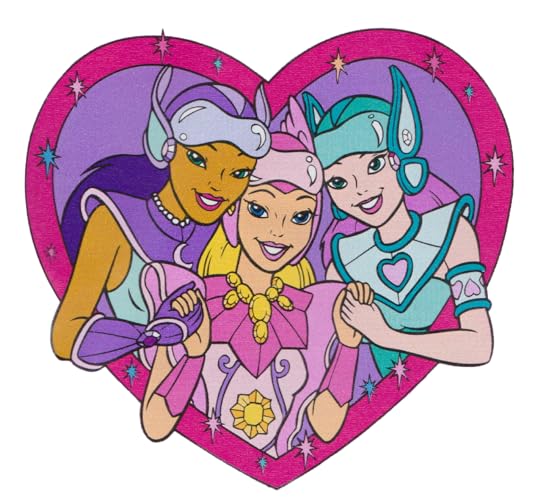
Where to watch: The Jewel Riders Archive channel on YouTube
Why to watch: This show is the ultimate escapist fantasy because it takes place in a beautiful pastel-colored dreamlike interpretation of Avalon that is powered by friendship and filled with faeries, unicorns, and mermaids.
My review: Jewel Riders is the Best Princess Show You've Never Seen
Once Upon a Time in Wonderland
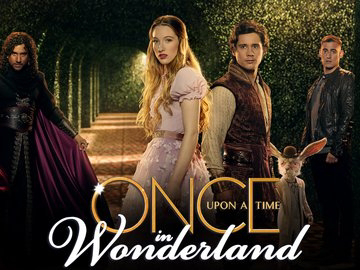
Where to watch: It's free on ABC's website!
Why to watch: When the writing on ABC's Once Upon a Time started to go south, they released this gem of a spinoff with thirteen fully fleshed out episodes containing one of the most beautiful love stories I have ever seen about a grown-up Alice in Wonderland and her relationship with a young genie from Agrabah.
My review: Once Upon a Time Wonderland Is the Best Spin-Off You've Never Seen
Sofia the First
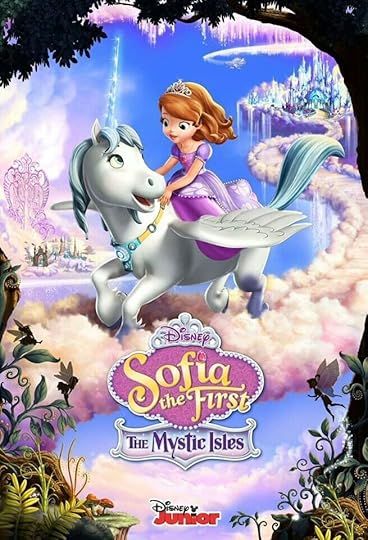
Where to watch: The series is available in full on Netflix.
Why to watch: Similar to Jewel Riders, this show fulfills an escapist fantasy of immersing yourself in the kid-friendly kingdom of Enchancia, which is filled with faeries, mermaids, and unicorns and features a kind-hearted protagonist who learns to wield incredible powers while training alongside the Disney Princesses.
My review: Forever Royal: The Last Sofia the First
Ashes of Love

Where to watch: The series is available in full on Netflix, but prepare to lose some sleep because it's addictive and long.
Why to watch: This Chinese escapist fantasy takes place in one of the most beautiful settings I have ever seen and centers around a "lost princess" archetype named Jinmi who is the secret daughter of the late queen of the Floral Realm. She travels to the breathtaking Heavenly Realm and falls in love with the Phoenix prince, where countless obstacles come between them.
My review: Breathtakingly Tranquil Princess Environments
Mia and Me
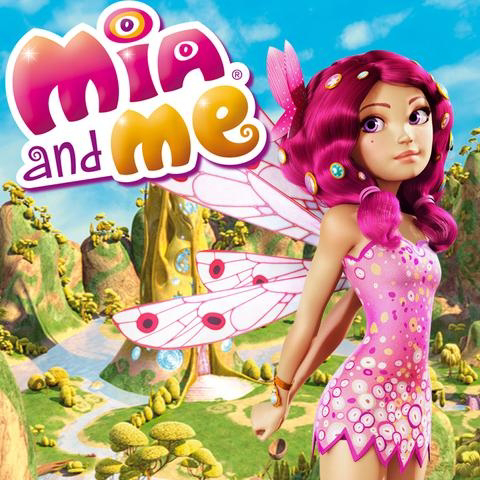
Where to watch: The first two seasons are available on Netflix. The latest season has a bunch of clips available on YouTube.
Why to watch: This Italian animated/live-action hybrid grants a young girl the fantasy of turning into a faery and flying around a magical storybook world full of unicorns and friendship.
H2O: Just Add Water/Mako Mermaids

Where to Watch: All seasons of both shows are available on Netflix.
Why to watch: If you'd rather be a mermaid than a faery, this Australian series is for you. H2O: Just Add Water features three ordinary teen girls who are granted extraordinary mermaid powres when they fall into an enchanted cave. Its spinoff series, Mako Mermaids, reveals more about where the mermaids came from but is less consistent with its storytelling and characters.
Tangled: The Series/Rapunzel's Tangled Adventure
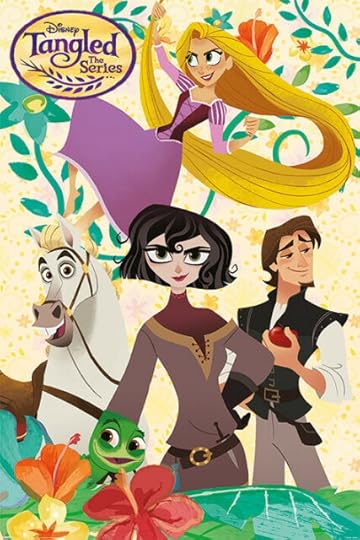
Where to watch: The first two seasons are available now on Disney+. The third season will be available in one month on April 23rd.
Why to watch: It fleshes out the kingdom of Corona that was introduced in Disney's 2010 Tangled feature and gives Rapunzel her first female friend and all the drama that comes with it.
My review: Rapunzel Reveals There Is More in You in the Tangled Finale
Crazy Ex-Girlfriend

Where to watch: The series is available in full on Netflix.
Why to watch: The show centers around a protagonist who wants to live her own romantic fairy tale right down to singing all her emotions out loud. It deconstructs the romance/fairy tale genre by exploring how to maintain a healthy mindset toward love without losing your princess-like optimism.
My review: Why All Princess Fans Should Watch Crazy Ex-Girlfriend
Elena of Avalor

Where to watch: The first two seasons are on Disney+, and all the episodes from season 3 so far are available on DisneyNOW with a cable login.
Why to watch: This Disney Princess series is set in the same world as Sofia the First, but contains a darker backstory for its protagonist. It is a culturally dynamic show that is filled with Aztec mythology and will be ending later this year, so now is a good time to get caught up.
My review: Elena Is Back and Better Than Ever!
Reign
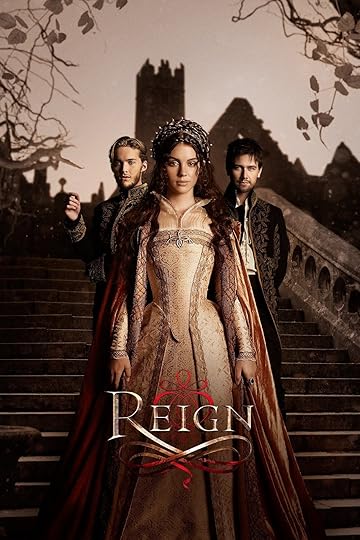
Where to watch: The series is available in full on Netflix.
Why to watch: This historical drama taught me a lot about the trials and tribulations of Mary, Queen of Scots without being boring like a documentary. I loved the storylines they incorporated to flesh out Mary's four ladies-in-waiting even though I was aware that most of them were probably fabricated.
My Review: Final Thoughts on the CW's Reign
She-Ra and the Princesses of Power
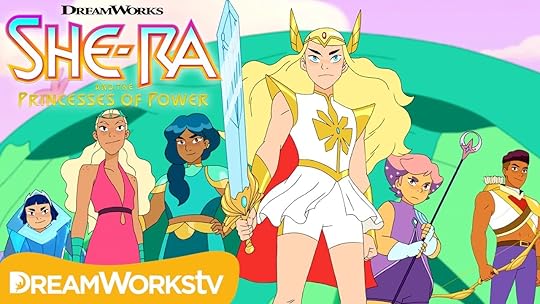
Where to watch: The first four seasons are currently available on Netflix with the final season slated for May 15th.
Why to watch: This show is an exponential improvement over its 1980s predecessor with dynamic character-driven stories that blur the lines between what it means to be a "good" or "bad" person.
My reviews: Season OneSeason TwoSeason ThreeSeason Four
Barbie
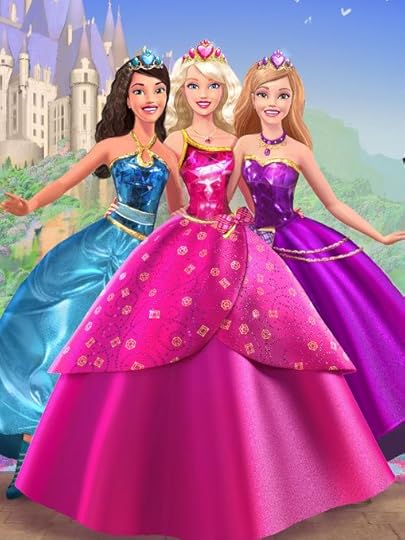
Where to watch: Several of the movies are available on Netflix as well as the Dreamhouse Adventures and Dreamhouse Adventures Go Team Roberts series. The earlier movies can be found online through less savory channels.
Why to watch: With her "Be anything" theme, Barbie has encouraged girls to dream by playing everything from fairy tale princesses to mermaids to faeries to superheroes. Her current Dreamhuse Adventures series on Netflix is pretty mediocre next to her movies, so I would only recommend the series if you're incredibly bored and have already seen everything else on this list.
My review: Barbie Is a Part-Time Princess
The Little Mermaid: The Animated Series
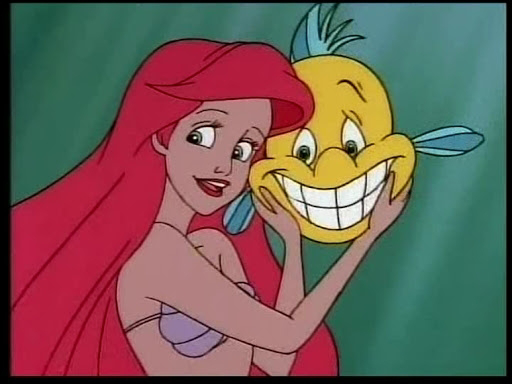
Where to watch: The series is available in full on Disney+.
Why to watch: If you didn't grow up with Ariel's adventures in Atlantica, your childhood was sorely lacking. There's no time like the present to catch up!
My review: How the Digital Age Revived The Little Mermaid Series
Published on March 22, 2020 11:17
March 20, 2020
Review: A Curse of Gems
If you need something lengthy to read during your extended self-quarantine, A Curse of Gems by Brittany Fichter is a terrific option. I was aware of this "Diamonds and Toads" retelling since its release last year but had little interest in reading it until it was offered it as a deal for National Fairy Tale Day and am so grateful I did. The book contained one of the most compelling love stories I ever read and built an incredibly robust world that was like a mature version of the Isle of the Lost from Disney's
Descendants
. It had a lot of the usual torture and religious subtext that Brittany Fichter is prone to including in her stories, but it didn't bother me as much it did in some of her other books. I was so engrossed in the characters, world, and elegant literary style that I couldn't wait to complete the uphill climb to the end.
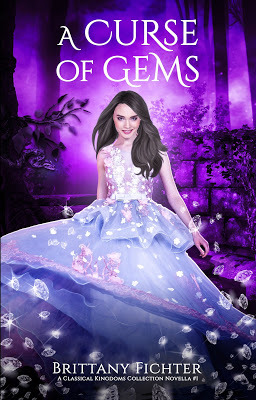
Like many people, I was familiar with the "Diamonds and Toads" fairy tale from the adaptation Gail Carson Levine published in her Princess Tales series. It's a very story that has tropes in common with other fairy tales such as a wicked stepmother and stepsister and an abused girl who marries out of her unfortunate situation thanks to a magic spell. I was surprised that Brittany Fichter could convert such a simple story into so long of a book until I dove into her rich and detailed world of Terrefantome, a place where dangerous criminals from other fairy tale kingdoms are exiled to for generations. The main character, Jaelle, was born of such a criminal, but she committed no crimes herself and had a good heart. That is why her stepsister, Selina, was determined to help her escape and find a place that would be more suitable for someone as pure as Jaelle. I appreciated that Brittany Fichter made the stepsister a close and loving ally of Jaelle because it made this book unique and reversed one of the overdone "Cinderella" tropes from the original fairy tale. The book follows the Charles Perrault story during when Selina makes a deal with a witch that causes her to release snakes and toads from her mouth whenever she speaks and Jaelle to release gems. From there, the story heavily diverts into its own mythology.
A Curse of Gems takes place in the same universe as Brittany Fichter's other fairy tale books and immediately follows the timeline of Silent Mermaid , her retelling of "The Little Mermaid." However, this book had none of the shortcomings that I found with Silent Mermaid. Unlike the weak-willed Arianna, Jaelle is an incredibly strong and sympathetic protagonist. She works as a healer, an art that she learned from her wicked stepmother, Chiara. As a result of living among criminals, she keeps her guard up at all times by shielding her face with an enchanted mask that reminds me of something from a Studio Ghibli film. At first, I thought the mask that Jaelle wore was a Victorian physician's mask to represent her status as a healer, but when I read on about how it is tradition in Terrefantome for young girls to wear masks to hide their beauty from lustful men until they find a husband, I realized that the mask was a symbol for virginity. It was made a point throughout the book that Jaelle was particularly stubborn about ever removing her mask unless she found a man that she loved with all her heart, which was considered unusual in Terrefantome. With all the religious subtext throughout the book, it became clear that this was a metaphor for Jaelle saving herself for marriage, something that Brittany Fichter would never say outright due to her clean style of storytelling.
Prince Lucas, the love interest, was the brother of the love interest from the prequel, Silent Mermaid. Lucas was every bit as developed as Jaelle. The book begins with a letter in which Lucas learns that the father of the girl he was pining for refuses to give him his blessing. Between his determination to win over the princess of his dreams and Jaelle's distrust of men, the two protagonists must jump through many hoops in order to prove themselves to each other. As she demonstrated in her Autumn Fairy trilogy, Brittany Fichter loves to torture lovers. In A Curse of Gems, most of this torture was simply a matter of the main characters opening themselves up from their misguided perspectives and allowing themselves to be loved. I grew invested in Jaelle and Lucas's romance early on, and it quickly became my primary motivation to complete the book. It was so satisfying to see a woman who grew up being told that all men are evil to be treated with kindness and finding a man to protect her in spite of her constant unfounded accusations of him. What they shared by the end of the book was so beautiful that it made the entire journey worthwhile.
A Curse of Gems surprised me. I was expecting an overly drawn-out adaptation of "Diamonds and Toads" filled with preachy religious torture. Even though it did contain many of the tropes I've come to expect from Brittany Fichter's writing, it was fully worth the time commitment in th eend. The love story was so pure and moving that it broke my heart on multiple occasions and inspired my imagination. I loved how much thought she put into the world of Terrefantome, including interesting little details such as its residents having the ability to turn invisible and innocent women being assigned protectors from lustful criminals. Though many of Brittany Fichter's previous books have been hit or miss for me, I fully recommend this one to anyone who loves princesses and romance.

Like many people, I was familiar with the "Diamonds and Toads" fairy tale from the adaptation Gail Carson Levine published in her Princess Tales series. It's a very story that has tropes in common with other fairy tales such as a wicked stepmother and stepsister and an abused girl who marries out of her unfortunate situation thanks to a magic spell. I was surprised that Brittany Fichter could convert such a simple story into so long of a book until I dove into her rich and detailed world of Terrefantome, a place where dangerous criminals from other fairy tale kingdoms are exiled to for generations. The main character, Jaelle, was born of such a criminal, but she committed no crimes herself and had a good heart. That is why her stepsister, Selina, was determined to help her escape and find a place that would be more suitable for someone as pure as Jaelle. I appreciated that Brittany Fichter made the stepsister a close and loving ally of Jaelle because it made this book unique and reversed one of the overdone "Cinderella" tropes from the original fairy tale. The book follows the Charles Perrault story during when Selina makes a deal with a witch that causes her to release snakes and toads from her mouth whenever she speaks and Jaelle to release gems. From there, the story heavily diverts into its own mythology.
A Curse of Gems takes place in the same universe as Brittany Fichter's other fairy tale books and immediately follows the timeline of Silent Mermaid , her retelling of "The Little Mermaid." However, this book had none of the shortcomings that I found with Silent Mermaid. Unlike the weak-willed Arianna, Jaelle is an incredibly strong and sympathetic protagonist. She works as a healer, an art that she learned from her wicked stepmother, Chiara. As a result of living among criminals, she keeps her guard up at all times by shielding her face with an enchanted mask that reminds me of something from a Studio Ghibli film. At first, I thought the mask that Jaelle wore was a Victorian physician's mask to represent her status as a healer, but when I read on about how it is tradition in Terrefantome for young girls to wear masks to hide their beauty from lustful men until they find a husband, I realized that the mask was a symbol for virginity. It was made a point throughout the book that Jaelle was particularly stubborn about ever removing her mask unless she found a man that she loved with all her heart, which was considered unusual in Terrefantome. With all the religious subtext throughout the book, it became clear that this was a metaphor for Jaelle saving herself for marriage, something that Brittany Fichter would never say outright due to her clean style of storytelling.
Prince Lucas, the love interest, was the brother of the love interest from the prequel, Silent Mermaid. Lucas was every bit as developed as Jaelle. The book begins with a letter in which Lucas learns that the father of the girl he was pining for refuses to give him his blessing. Between his determination to win over the princess of his dreams and Jaelle's distrust of men, the two protagonists must jump through many hoops in order to prove themselves to each other. As she demonstrated in her Autumn Fairy trilogy, Brittany Fichter loves to torture lovers. In A Curse of Gems, most of this torture was simply a matter of the main characters opening themselves up from their misguided perspectives and allowing themselves to be loved. I grew invested in Jaelle and Lucas's romance early on, and it quickly became my primary motivation to complete the book. It was so satisfying to see a woman who grew up being told that all men are evil to be treated with kindness and finding a man to protect her in spite of her constant unfounded accusations of him. What they shared by the end of the book was so beautiful that it made the entire journey worthwhile.
A Curse of Gems surprised me. I was expecting an overly drawn-out adaptation of "Diamonds and Toads" filled with preachy religious torture. Even though it did contain many of the tropes I've come to expect from Brittany Fichter's writing, it was fully worth the time commitment in th eend. The love story was so pure and moving that it broke my heart on multiple occasions and inspired my imagination. I loved how much thought she put into the world of Terrefantome, including interesting little details such as its residents having the ability to turn invisible and innocent women being assigned protectors from lustful criminals. Though many of Brittany Fichter's previous books have been hit or miss for me, I fully recommend this one to anyone who loves princesses and romance.
Published on March 20, 2020 17:08
March 16, 2020
Where Did Princess Barbie Go?
It's been almost three years since the last Barbie movie dropped on Netflix. Since then, it appeared as though she retired from her fairy tale princess days in favor of the Dreamhouse Adventures series, which also premiered on Netflix shortly after Dolphin Magic. This was a big disappointment to those of us who loved Barbie's magical and sometimes musical masterpieces that came out two to three times a year between 2001 and 2017. Seeing Barbie hanging out with her sisters in modern-day Malibu in Dreamhouse Adventures isn't nearly as interesting or exciting as discovering an enchanted realm, saving the world, or switching places with a princess. That's why I was elated to learn that she would release a 72-minute feature this year called Princess Adventure. Is Princess Barbie back?
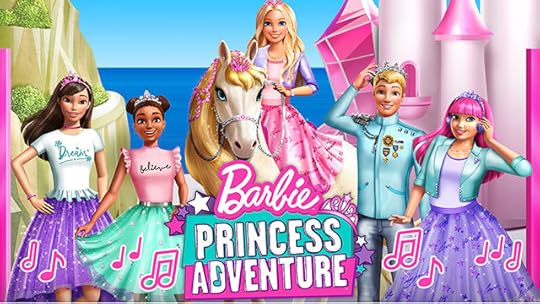
Though Princess Adventure is slated for this year, there has been no trailer or release date, or really any other identifying information outside of a dual poster coupled with an ad for a new Thomas the Tank Engine special. Some fans speculate that Princess Adventure might by the first full-length Dreamhouse Adventures special instead of a standalone movie like the others. For me, that would be a little disappointing because it would force the film to stay grounded in a more realistic world as opposed to the incredible places that Barbie's movies have taken us in the past such as Fairytopia, Gloss Angeles, and Oceana. If it does take place in the same continuity as Dreamhouse Adventures, I would question why Barbie's sisters don't appear in the poster, especially after she has been in several movies with them unless they will be used as a framing device like Kelly was in The Nutcracker . Barbie tells us that we can be anything, so I would love to see an unlimited scope for this new adventure outside of the confines of the Dreamhouse.
Through the dearth of information about the movie, there have been some leaks of dolls that will accompany it. Barbie and her friends look very modern in their t-shirts and chiffon skirts featuring cursive words of inspiration like "Dream" and "Believe." Ken seems a bit out of place with a huge crown, formal jacket, and jeans. While this style does match my personal fashion as a casual princess in a modern world, there is a jarring lack of creativity to it. Barbie has always been a huge proponent of playing dress-up, and these dolls seem rather plain in comparison to the elaborate gowns she's worn in her other movies. The fact that the poster and dolls feature Barbie and her peers Daisy, Nikki, and Teresa hearkens back to her other girl-power team-up films such as The Three Musketeers , Princess Charm School , and Spy Squad . The question remains as to when we will see these girls in action. Did the coronavirus scare them off?
A lot of sources claim that the movie is scheduled for early 2020, but the lack of a release date when we are already a quarter of the way into the year says otherwise. I'm not sure if they're going through distribution or marketing delays, but I do know that I would like to see this movie sooner rather than later. We can all use more princesses in our lives during these tough times and are long overdue for a new Barbie movie. I'm not sure if the rise of streaming services lead to the halt in production, but it seems like Mattel chose Netflix as Barbie's new home now that DVDs have dropped in popularity. It's also probably cheaper to produce simple Dreamhouse Adventure episodes with minimal sets than feature-length movies with original songs and settings. Therefore, I'm glad they're willing to put in the extra effort for one more princess adventure.

Barbie discovers what it means to be a modern princess in this full-length, original musical when she switches places with her royal doppelganger. Barbie helps a young monarch find her voice and use her position for social change.Does that logline sound familiar? It should. This would be the third time that Barbie releases a movie with that exact same plot. The first time was in 2004 with The Princess and the Pauper, the greatest Barbie movie ever made (fight me). Eight years later, they tried to modernize the story with The Princess and the Popstar, which recycled some of the concepts but also introduced contemporary technology such as tablets and smartphones into the mix. The upcoming Princess Adventure appears to take that a step further with Barbie and her friends dressing up in modern fashion and exploring the theme that was popularized in the latest Aladdin remake of princesses using their power for good and becoming great leaders. It is possible that we will hear a new remix of "To Be a Princess" among the movie's six songs, but we will likely get several original hits as well since the poster features Barbie's new plus-sized bff Daisy rocking her DJ headphones.
Though Princess Adventure is slated for this year, there has been no trailer or release date, or really any other identifying information outside of a dual poster coupled with an ad for a new Thomas the Tank Engine special. Some fans speculate that Princess Adventure might by the first full-length Dreamhouse Adventures special instead of a standalone movie like the others. For me, that would be a little disappointing because it would force the film to stay grounded in a more realistic world as opposed to the incredible places that Barbie's movies have taken us in the past such as Fairytopia, Gloss Angeles, and Oceana. If it does take place in the same continuity as Dreamhouse Adventures, I would question why Barbie's sisters don't appear in the poster, especially after she has been in several movies with them unless they will be used as a framing device like Kelly was in The Nutcracker . Barbie tells us that we can be anything, so I would love to see an unlimited scope for this new adventure outside of the confines of the Dreamhouse.
Through the dearth of information about the movie, there have been some leaks of dolls that will accompany it. Barbie and her friends look very modern in their t-shirts and chiffon skirts featuring cursive words of inspiration like "Dream" and "Believe." Ken seems a bit out of place with a huge crown, formal jacket, and jeans. While this style does match my personal fashion as a casual princess in a modern world, there is a jarring lack of creativity to it. Barbie has always been a huge proponent of playing dress-up, and these dolls seem rather plain in comparison to the elaborate gowns she's worn in her other movies. The fact that the poster and dolls feature Barbie and her peers Daisy, Nikki, and Teresa hearkens back to her other girl-power team-up films such as The Three Musketeers , Princess Charm School , and Spy Squad . The question remains as to when we will see these girls in action. Did the coronavirus scare them off?
A lot of sources claim that the movie is scheduled for early 2020, but the lack of a release date when we are already a quarter of the way into the year says otherwise. I'm not sure if they're going through distribution or marketing delays, but I do know that I would like to see this movie sooner rather than later. We can all use more princesses in our lives during these tough times and are long overdue for a new Barbie movie. I'm not sure if the rise of streaming services lead to the halt in production, but it seems like Mattel chose Netflix as Barbie's new home now that DVDs have dropped in popularity. It's also probably cheaper to produce simple Dreamhouse Adventure episodes with minimal sets than feature-length movies with original songs and settings. Therefore, I'm glad they're willing to put in the extra effort for one more princess adventure.
Published on March 16, 2020 18:19
March 15, 2020
Review: The Silent Princess
Princess League by Mira Crest was another series I learned about through this year's National Fairy Tale Day. The Silent Princess, a retelling of "The Little Mermaid," appears to be the first book, despite the big number "2" on the cover above the title. The Hidden Princess, which has a number "1" on the cover, is scheduled to come out next month. Princess League series is promoted as "Princesses meet Avengers," which sounds pretty similar to another series I read recently. It appears that all the princesses from the series are supposed to have some sort of superpower and that each book ends with some sort of cataclysmic battle that affects the lives of thousands of people. Though The Silent Princess was not my favorite adaptation of "The Little Mermaid," it did bring a few elements to it that have not been done before.
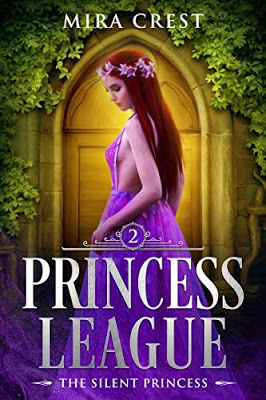
The Silent Princess starts out with a seemingly ordinary girl on land named Marina who is working at some sort of orphanage or sweatshop run by a wicked tyrant named Pratt. When she attempts to protect one of her friends from Pratt's abuse, Marina discovers that she has mysterious ice powers. Besides knowing nothing about these powers, she also can't recall where she came from or if she had always been mute. All she can remember is a strange boy she keeps seeing in her dreams. After Pratt kicks her out for witchcraft, Marina is taken in by a kind woman named Emma until she inevitably finds the boy from her dreams and decides to chase after him. What made this adaptation unique is that Marina spends quite a bit of time on land before chasing the prince and learning about some of the more wicked aspects of humanity. The first portion of the book reminded me of Matilda, a story I wouldn't ordinarily associate with "The Little Mermaid."
The course of the story changes dramatically after Marina decides to chase after Prince Dominic. Not long after finding him on a ship, she encounters her mermaid family who tells her who she really is and why her memories and voice were taken away. An interesting reversal from most versions of the fairy tale was that much of the time that Marina spent with Dominic took place in the underwater kingdom instead of his kingdom on land. They used a magical bubble membrane called an "etherfin" to breathe underwater. It was nice to get to know some of Marina's sisters and see how badly they wanted her to stay with them, something that was inherent to the original fairy tale but excluded from the Disney movie. I couldn't help laughing when at the reveal that Marina's father was named King Trenton and behaved exactly like King Triton from the Disney movie. Marina's name was trite enough already, but "Trenton" sounds like the dollar store version of "Triton."
The fun whimsy of the underwater kingdom was quickly shattered in the final portion of the book when catastrophe struck both worlds. The death toll of unimportant characters in The Silent Princess rivals that of Maleficent 2 . In some ways, this book wasn't as dark as the original fairy tale, yet there are so many people who die in it that it doesn't quite hit the impact it should due to the lack of names and personalities for most of them. Making the ocean fill with blood didn't leave a particularly pleasant image in my head. There were two villains in this book. While one was extremely obvious, the other was a surprise twist that came entirely out of the blue. It's one of those cases where a character meets someone by chance, and they turn out to be this legendary figure that's directly connected to their life. I didn't understand why Marina would possibly forgive this person after learning what they had done.
The Silent Princess was somewhat uneven. The story had some creative and interesting elements to it. At the same time, it was clear that it had not been proofread, and none of the characters had any semblance of a personality through their dialogue. During the parts where Marina was silent, there was no consistency around what she communicated using a pen or sign language. The lack of quotes or italics sometimes made it hard to tell what was supposed to be dialogue for her. It felt like the book was trying to be too many different things at the same time and failed to be any of them as a result. My favorite part was the opening chapters where Marina learned a little about life on land without quite understanding why she was there. When it tried to turn into a big war epic at the end, it lost most of my interest. However, I think the book jumped the shark the moment it introduced King Trenton.

The Silent Princess starts out with a seemingly ordinary girl on land named Marina who is working at some sort of orphanage or sweatshop run by a wicked tyrant named Pratt. When she attempts to protect one of her friends from Pratt's abuse, Marina discovers that she has mysterious ice powers. Besides knowing nothing about these powers, she also can't recall where she came from or if she had always been mute. All she can remember is a strange boy she keeps seeing in her dreams. After Pratt kicks her out for witchcraft, Marina is taken in by a kind woman named Emma until she inevitably finds the boy from her dreams and decides to chase after him. What made this adaptation unique is that Marina spends quite a bit of time on land before chasing the prince and learning about some of the more wicked aspects of humanity. The first portion of the book reminded me of Matilda, a story I wouldn't ordinarily associate with "The Little Mermaid."
The course of the story changes dramatically after Marina decides to chase after Prince Dominic. Not long after finding him on a ship, she encounters her mermaid family who tells her who she really is and why her memories and voice were taken away. An interesting reversal from most versions of the fairy tale was that much of the time that Marina spent with Dominic took place in the underwater kingdom instead of his kingdom on land. They used a magical bubble membrane called an "etherfin" to breathe underwater. It was nice to get to know some of Marina's sisters and see how badly they wanted her to stay with them, something that was inherent to the original fairy tale but excluded from the Disney movie. I couldn't help laughing when at the reveal that Marina's father was named King Trenton and behaved exactly like King Triton from the Disney movie. Marina's name was trite enough already, but "Trenton" sounds like the dollar store version of "Triton."
The fun whimsy of the underwater kingdom was quickly shattered in the final portion of the book when catastrophe struck both worlds. The death toll of unimportant characters in The Silent Princess rivals that of Maleficent 2 . In some ways, this book wasn't as dark as the original fairy tale, yet there are so many people who die in it that it doesn't quite hit the impact it should due to the lack of names and personalities for most of them. Making the ocean fill with blood didn't leave a particularly pleasant image in my head. There were two villains in this book. While one was extremely obvious, the other was a surprise twist that came entirely out of the blue. It's one of those cases where a character meets someone by chance, and they turn out to be this legendary figure that's directly connected to their life. I didn't understand why Marina would possibly forgive this person after learning what they had done.
The Silent Princess was somewhat uneven. The story had some creative and interesting elements to it. At the same time, it was clear that it had not been proofread, and none of the characters had any semblance of a personality through their dialogue. During the parts where Marina was silent, there was no consistency around what she communicated using a pen or sign language. The lack of quotes or italics sometimes made it hard to tell what was supposed to be dialogue for her. It felt like the book was trying to be too many different things at the same time and failed to be any of them as a result. My favorite part was the opening chapters where Marina learned a little about life on land without quite understanding why she was there. When it tried to turn into a big war epic at the end, it lost most of my interest. However, I think the book jumped the shark the moment it introduced King Trenton.
Published on March 15, 2020 12:22



